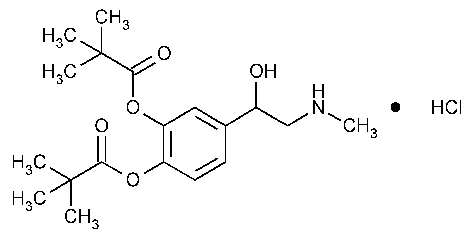Dipivefrin Hydrochloride
Propanoic acid,2,2-dimethyl-,4-[1-hydroxy-2-(methylamino)ethyl]-1,2-phenylene ester,hydrochloride,(±)-.
(±)-3,4-Dihydroxy-a-[(methylamino)methyl]benzyl alcohol 3,4-dipivalate hydrochloride [64019-93-8].
»Dipivefrin Hydrochloride contains not less than 98.5percent and not more than 101.5percent of C19H29NO5·HCl,calculated on the dried basis.
Packaging and storage—
Preserve in tight containers.
Identification—
A:
Infrared Absorption á197Kñ.
B:
The retention time of the major peak in the chromatogram of the Assay preparationcorresponds to that in the chromatogram of the Standard preparation,as obtained in the Assay.
C:
Asolution (1in 100)meets the requirements of the tests for Chloride á191ñ.
Melting range á741ñ:
between 155 and 165
and 165 ,but the range between beginning and end of melting does not exceed 2
,but the range between beginning and end of melting does not exceed 2 .
.
Loss on drying á731ñ—
Dry it in a suitable vacuum drying tube over phosphorus pentoxide at 60 for 6hours:it loses not more than 1.0%of its weight.
for 6hours:it loses not more than 1.0%of its weight.
Residue on ignition á281ñ:
not more than 0.3%.
Heavy metals,Method Iá231ñ:
not more than 0.0015%.
Iron á241ñ:
not more than 5ppm.
Hydroxylamine solution—
Dissolve 5g of hydroxylamine hydrochloride in 50mLof water.
Triazine solution—
Dissolve 125mg of 2,4,6-tri-(2-pyridyl)-S-triazine in 100mLof methanol.
Standard solution—
Into a 50-mLcolor-comparison tube pipet 1mLof Standard iron solution,add 42.0mLof water,and mix.
Test solution—
Into a 50-mLcolor-comparison tube add 2.0g of Dipivefrin Hydrochloride,43.0mLof water,and mix.
Procedure—
To each of the tubes containing the Standard solutionand the Test solution,add 5.0mLof Hydroxylamine solution,2.0mLof Triazine solution,and mix:the color of the solution from the Test solutionis not darker than that of the solution from the Standard solution.
Assay—
Mobile phase—
Prepare a mixture of acetonitrile,0.014Msodium dodecyl sulfate,and glacial acetic acid (24:15:1).
Standard preparation—
Dissolve a suitable quantity of USP Dipivefrin Hydrochloride RS,accurately weighed,in 0.0015Nhydrochloric acid to obtain a solution having a known concentration of about 5mg per mL.
Assay preparation—
Prepare as directed for Standard preparation,using 500mg of Dipivefrin Hydrochloride,accurately weighed,in place of the Reference Standard.
Chromatographic system (see Chromatography á621ñ)—
The liquid chromatograph is equipped with a 254-nm detector and a 4-mm ×30-cm column that contains packing L1.The flow rate is about 2mLper minute.Chromatograph the Standard preparation,and record the peak responses as directed for Procedure:the column efficiency is not less than 500theoretical plates;the tailing factor for the major peak is not more than 1.5;and the relative standard deviation for replicate injections is not more than 2.0%.
Procedure—
Separately inject equal volumes (about 20µL)of the Standard preparationand the Assay preparationinto the chromatograph by means of a suitable microsyringe or sampling valve,record the chromatograms,and measure the responses for the major peaks.Calculate the quantity,in mg,of C19H29NO5·HCl in the portion of Dipivefrin Hydrochloride taken by the formula:
100C(rU/rS),
in which Cis the concentration,in mg per mL,of USP Dipivefrin Hydrochloride RSin the Standard preparation;and rUand rSare the peak responses obtained from the Assay preparationand the Standard preparation,respectively.
Auxiliary Information—
Staff Liaison:Lawrence Evans,III,Ph.D.,Scientist
Expert Committee:(PA6)Pharmaceutical Analysis 6
USP28–NF23Page 672
Pharmacopeial Forum:Volume No.28(4)Page 1105
Phone Number:1-301-816-8389
